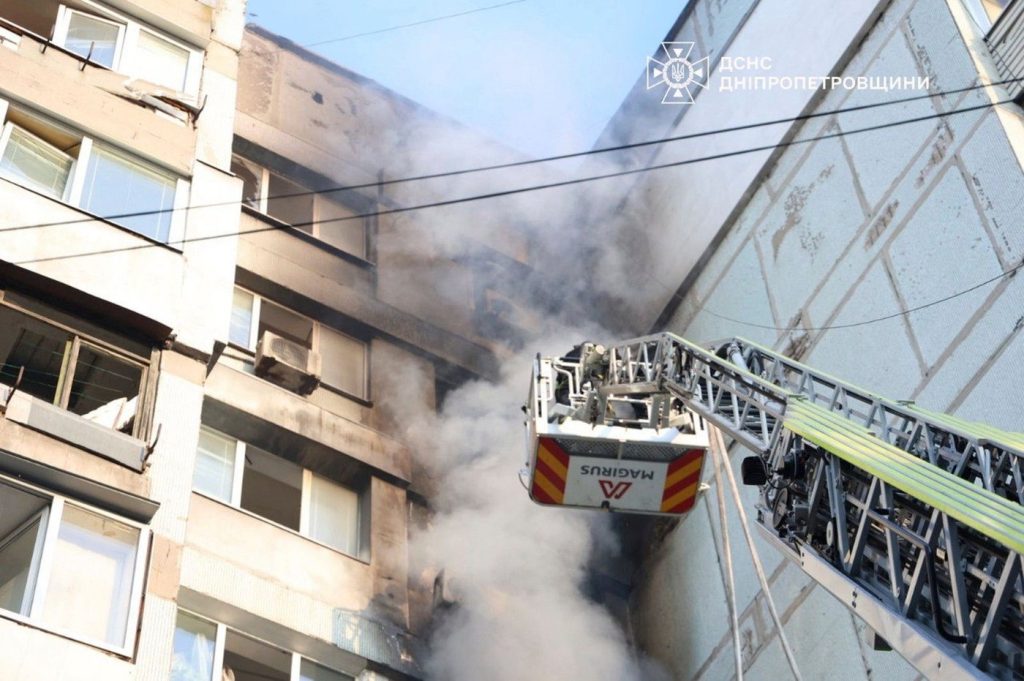KYIV, Ukraine (AP) — A significant missile and drone offensive was launched by Russia early Saturday, targeting various regions across Ukraine and resulting in the deaths of at least three individuals, while dozens were injured, as reported by Ukrainian officials. Ukrainian President Volodymyr Zelenskyy indicated that the attacks affected nine regions, including Dnipropetrovsk, Mykolaiv, Chernihiv, Zaporizhzhia, Poltava, Kyiv, Odesa, Sumy, and Kharkiv.
Zelenskyy highlighted that the strikes aimed at Ukrainian infrastructure, residential neighborhoods, and civilian facilities. He specifically noted that one missile, which was armed with cluster munitions, struck a multi-story building in the city of Dnipro. “Each such strike is not a military necessity but a deliberate strategy by Russia to intimidate civilians and destroy our infrastructure,” he stated in a communication through his official Telegram account.
In the central Dnipropetrovsk region, local governor Serhii Lysak reported that at least 30 individuals were wounded. The eastern city of Dnipro experienced damage to several high-rise buildings and homes. Further strikes occurred in the Kyiv region, affecting areas such as Bucha, Boryspil, and Obukhiv, where a residential home and vehicles sustained damage. In western Lviv, Governor Maxim Kozytsky confirmed that two cruise missiles were intercepted and destroyed.
According to the Ukrainian Air Force, Russia deployed a total of 619 missiles and drones in the assault, comprising 579 drones, eight ballistic missiles, and 32 cruise missiles. Ukrainian defenses managed to neutralize 552 drones alongside two ballistic missiles and 29 cruise missiles. The Air Force attributed significant defensive actions to tactical aviation, particularly highlighting the effectiveness of F-16 fighters in intercepting enemy cruise missiles. This defense reflects the enhanced capabilities provided by Western military support.
In a separate incident, Russia's Defense Ministry refuted claims that its aircraft violated Estonian airspace after reports emerged of three Russian fighter jets entering Estonian territory unauthorized for approximately 12 minutes. This event, described as "unprecedentedly brazen" by Estonia’s top diplomat, occurred shortly after NATO planes intercepted Russian drones over Poland, raising concerns that the conflict involving Moscow and Ukraine could escalate into a broader regional conflict.
The Russian statement emphasized that their fighter jets maintained operations in neutral Baltic Sea waters, remaining over 3 kilometers (1.8 miles) away from Estonia’s Vaindloo Island. It claimed that the flight had been conducted in accordance with international airspace regulations, although details regarding the monitoring of the operation were not provided.
Following the airspace violation reports, Estonian officials summoned a Russian diplomat to express their concerns and indicated a move to initiate consultations among NATO allies under Article 4, which addresses threats to territorial integrity and security.
Looking ahead to international engagements, President Zelenskyy expressed hope for finalizing long-term security guarantees during upcoming discussions at the United Nations General Assembly in New York. He noted that European nations are prepared to advance these security frameworks, contingent on continued involvement from the United States. Zelenskyy indicated that discussions had occurred at multiple levels, involving military leadership from both Europe and the U.S.
Additionally, Zelenskyy emphasized that sanctions against Russia must remain an option if peace negotiations falter, asserting that he plans to address this with U.S. President Donald Trump. He mentioned, “If the war continues and there is no movement toward peace, we expect sanctions,” and added that Trump is looking for decisive actions from Europe in response to the ongoing conflict.










